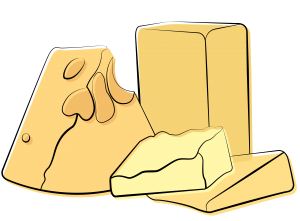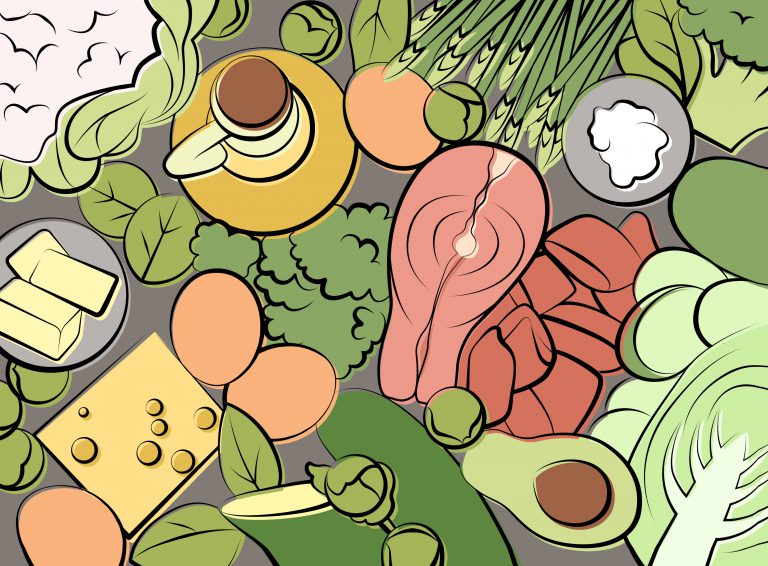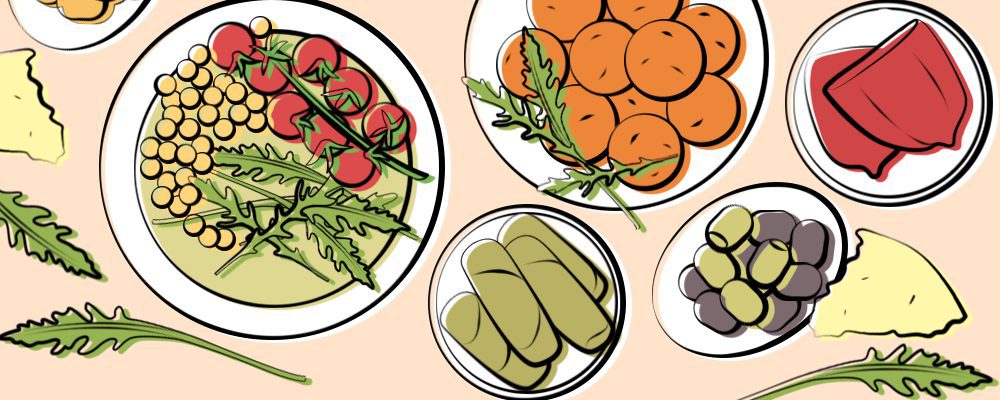Learn all about the common migraine food triggers, how to identify your unique triggers, and ways to use your diet to support healing.
There are many different kinds of triggers that can bring on a migraine attack. These include a wide range of factors like stress, missing sleep, weather changes, and food.
Dietary triggers are some of the most commonly reported triggers among migraine patients. Studies have shown that between 10 and 64% of migraineurs say that certain foods trigger migraines for them.
It is not surprising, then, that many people who get migraines change up their diets in order to prevent headaches. This is especially true of migraine sufferers who get frequent attacks and who have auras.
If you have not yet looked at food triggers as part of your approach to managing your migraines, then it might be time to consider doing some investigating. By taking the time to determine which foods you might be sensitive to, you might just be able to avoid some – or even all – of of your migraines.
Eating a healthy, nutritious diet and avoiding those foods that bring on a migraine attack can help you on your path to managing your symptoms and becoming free from migraines.
Which foods trigger migraine?
An important thing to understand when it comes to migraine triggers of any sort is that everyone is unique. What might bring on a migraine in one person could be totally safe for another. Each person will respond to various environmental factors differently.
This is true of food triggers. While cheese and red wine might trigger an attack for one person, it might be chocolate and onions for another.
That being said, there are some foods that are more commonly reported to trigger migraines than others.
Common migraine food triggers
- Alcohol
- Apples
- Chocolate
- Citrus fruits and juices
- Dairy (especially aged cheese)
- Eggs
- Gluten
- Deli meats
- Leftovers
- MSG (monosodium glutamate, a flavor enhancer)
- Nuts and peanuts
- Onions
- Overripe fruits like bananas or avocados
- Highly-processed foods (foods that have been heavily altered from their natural form in order to preserve, add flavor, change texture, etc. They usually come in lots of packaging and have long lists of ingredients.)
- Red wine
- Smoked meats or fish
- Sugar-free and diet products
- Tomatoes
- Vinegars
So what is it about these foods in particular that tend to make them triggers? What is in them that migraineurs are sensitive to?
Certain substances in particular food items are likely to act as triggers for many migraine sufferers. Many of the common migraine food triggers listed above contain those ingredients.
Let’s take a closer look at some of these common ingredients and categories of dietary migraine food triggers:
1. Alcohol
Alcohol itself can trigger a migraine for many. On top of that, many alcoholic beverages have other triggering chemicals in them, like tyramine or tannins (read more about those below).
Common food sources: Beer, wine, liquor, mixed drinks, canned cocktails, and more.

2. Artificial additives
Many highly-processed foods contain artificial additives. Processed foods are foods that have been heavily altered from their natural state and that contain long lists of ingredients and additives. Those additives can include everything from preservatives to artificial dyes to sweeteners. Some additives that are associated with migraines include aspartame (an artificial sweetener), food dyes, and MSG.
Common food sources: Highly-processed foods, sugar-free foods, prepared meals, canned foods, instant foods, sauces like soy sauce, deli meats, candy, diet products, diet sodas, and more.
3. Caffeine
Some people find that small amounts of caffeine can help their headaches. But too much can be a problem, too. When you drink too much caffeine daily, it can cause you to get withdrawal symptoms when you go too long without it. And those symptoms can include getting a migraine. Caffeine and coffee are some of the most commonly reported migraine food triggers.
Common food sources: Coffee, caffeinated tea, sodas, chocolate, energy drinks, and more.
4. Histamine
Foods that contain the compound histamine can be problematic for many migraineurs. Some people are intolerant to histamine, meaning that when they eat foods that contain it they get several symptoms, including migraines.
Common food sources: Fermented foods, aged cheese, vinegars, alcoholic beverages, cured meats or fish, tomatoes, tea, yeast, preservatives, citrus fruits, chocolate, avocado, and more.
5. Nitrates and nitrites
These chemicals are used to preserve foods, especially highly-processed foods that come in lots of packaging and have long lists of ingredients. Nitrates and nitrites are very common dietary migraine triggers.
Common food sources: Deli meats, cured meats, hot dogs, sausage, bacon, pepperoni, canned foods, highly-processed foods, and more.
6. Sulfites
Sulfites are another type of preservative commonly used in processed foods. Some migraine sufferers can be sensitive to this particular preservative, and it can bring on a migraine.
Common food sources: Wine, dried fruits, processed foods, canned fruits and vegetables, fruit and vegetable juices, condiments, drink mixes, pastries, shredded coconut, trail mix, and more.
7. Tannins
You know that particular type of bitterness you feel on your tongue when you consume things like tea, wine, or grapes? That comes from tannins. This substance, which comes from certain plants, can bring on migraine attacks. It is the reason why many migraine sufferers have to avoid red wine.
Common food sources: Red wine, tea, grapes, apples and pears (mostly red ones), apple juice, apple cider, walnuts, chocolate, and more.
8. Tyramine
Many foods liable to trigger migraine – like aged cheese, onions, citrus fruits, and cured meats – contain an amino acid called tyramine. While this is a natural substance, certain foods have quite a lot of it. And for some people, tyramine acts as a migraine trigger, so tyramine-rich foods can be a problem. Be aware that as food gets older (as with leftovers) the tyramine content rises.
Common food sources: Aged cheese, fermented drinks, soy products like tofu and miso, onions, citrus fruits, overripe fruits like avocados and bananas, vinegar, fava and broad beans, red wine, nuts, leftover food, and more.
Depending on your unique body, you may be sensitive to none or all of the categories of triggers listed above. It is important to find out what foods you individually react to, and in particular what ingredients and substances are at the root of the problem.
In general, if you have migraines it might be a good idea to avoid foods like processed foods, aged or fermented foods, alcohol, and caffeine, as these tend to have a lot of the triggering substances in them.
How to determine your unique migraine food triggers
As you know if you have migraines, there are usually many different factors, not just one, that tend to precipitate an attack. And that makes it complicated to sort out what might be contributing to your symptoms.

It can be really difficult to pin down the cause and effect relationship between certain foods and migraine attacks.
To figure out your unique food triggers, you must be willing to experiment and find what works best for you and your unique body. This requires putting in the time and effort to go through a process of trial and error.
Here are some tips for how to go about figuring out which foods you should avoid:
1. Keep a headache diary
It is important to learn your patterns. A headache diary will help you do just that, and it will help you to identify possible triggers – dietary and otherwise.
Keep a daily diary, where you record symptoms, pain levels, activities, stress, food intake, and any other important information you can. Then look back over your journal over time and see if you can puzzle out any patterns. If every time you eat a certain food you get a migraine that day or the next day, it may be a trigger.
If keeping track of things digitally appeals to you, then you might consider trying apps like Migraine Buddy, M-Sense, and others.
2. Try eliminating certain foods and reintroducing them one at a time
If you suspect a certain food might be a trigger for you, test it out. Remove that food from your diet for a period of time (at least several weeks). Then reintroduce it and see what happens. This can help you to see if that food really is one of the things that brings on your symptoms.
Some migraine sufferers find that doing a specific elimination diet can help. This involves removing many foods from your diet at once, and then slowly reintroducing them while you monitor your reactions.
3. Remember that not all effects are immediate
Some foods can trigger a migraine within the hour. But in other cases, it might take much longer for the effect to take place. Try to pay attention and stay very aware of what is going on for you and the symptoms that arise over time.
4. Consider allergy testing
If you are allergic to certain foods or substances, then that could be what is at the root of the issue. Reactions to foods can manifest as many different symptoms, and headaches and migraine-like symptoms can be among them.
There is some evidence that IgG antibody testing can be helpful for migraineurs to determine what foods to avoid in their diet. In several studies, migraine frequency has decreased after individuals removed the foods that came up on this type of allergy test.
There are several brands available online that sell at-home food sensitivity testing kits. However, it is recommended to work with a doctor, nutritionist, or other holistic healthcare practitioner to get proper testing done.
5. Remember that you are unique
Eliminating foods from your diet is all about paying attention and learning what works for you. Your migraine diet might look different than anybody else’s. Try to get in tune with your unique body and learn how specific foods or ingredients affect you.
Can eating certain foods help you avoid migraines?
Diet and nutrition for migraines is just as much about what you do eat as what you don’t eat. You’ve now learned how to determine what foods to avoid. But what about the foods that can help you? Foods you can eat that might be able to help you prevent migraines from occurring in the first place?
First, you’ll want to load up your diet with pain-safe foods that don’t tend to be associated with migraines. Pain-safe foods include things like cooked vegetables, rice, and non-citrus fruits. Nutrient-dense fruits and vegetables should play a starring role in your migraine prevention diet, and most are generally safe for migraine sufferers.
In addition, increase your intake of certain nutrients that have been linked to a decrease in migraine frequency and severity. These include riboflavin, magnesium, omega-3 fatty acids like EPA, and CoQ10.

Below is a breakdown of each of these nutrients and the common foods that contain them.
Riboflavin. Also known as vitamin B2, riboflavin is one of the nutrients that is found to be most helpful with migraine prevention.
Common food sources: Eggs, meat, poultry, fish, green vegetables (like broccoli, spinach, and asparagus), dairy, and almonds.
How much you need: Men need 1.3 mg and women need 1.1 mg daily.
Magnesium. This is one of the most important minerals for preventing migraines.
Common food sources: Green leafy vegetables, nuts, seeds, legumes, fish, and meat.
How much you need: Men need 400-420 mg daily and women need 310-320 mg daily.
Omega-3 fatty acids. Omega-3 fatty acids like EPA are healthy fats that can lower inflammation and help improve migraines.
Common food sources: Fish (like salmon, tuna, mackerel, and sardines), nuts and seeds (like chia, walnut, and flax), and flaxseed oil.
How much you need: Two servings of fish per week provides a healthy amount of omega 3s. Supplements of 1 g per day can also be used.
CoQ10. CoQ10 is a coenzyme that helps your cells generate energy. It has been studied as a useful nutrient to help prevent migraines.
Common food sources: Fish, legumes, nuts and seeds, meat, broccoli, cauliflower, and strawberries.
How much you need: There are no formal daily intake recommendations for CoQ10. However, supplement doses generally range from 30 to 100 mg/per day and are considered safe.
Foods loaded with these nutrients can be great for helping your migraines in the long run.
Are there certain kinds of diets that are good for migraines?
Again, it is important to emphasize that everyone is unique and you need to find what works for you when it comes to your diet. However, research has shown that certain types of diets can be of particular benefit to migraine sufferers. These include:
- Plant-based vegan diets. Certain studies have found vegan diets to be useful in reducing migraine pain.
- The keto diet. The ketogenic diet, which is a high-fat and low-carbohydrate diet, has been shown to be helpful for improving migraines.
However, there is no one-size-fits-all diet for migraine. Keep fine tuning until you find a diet that works best for you.
Other dietary tips for avoiding migraines
When it comes to diet and migraines, there are a few more things that you should keep in mind if you want to stay healthy and avoid symptoms.
- Don’t skip meals. It turns out that it’s not just what you eat, but when you eat it, that is important for migraines. Missing meals is frequently reported as a migraine trigger.
- Try eating small, frequent meals throughout the day. Because going too long without food can trigger a migraine, consider eating smaller meals throughout the day rather than a few big ones. This can help to keep your blood sugar stable and prevent attacks from occurring.
- Stay hydrated. Drink plenty of water throughout the day, as dehydration can be another migraine trigger. A good rule of thumb is to take your body weight in pounds and divide that in half. The resulting number is the amount of ounces you should drink each day.
- Eat a well-rounded diet. Make sure to get all the nutrients you can to support your overall health and wellbeing, so that you are giving your body the best chance possible in fighting off migraine attacks.
What can you eat when you have a migraine?
It can take time to discover your unique triggers and figure out a dietary pattern that works best for you. But once you do, it can help you to reduce your symptoms.
Unfortunately for many people, eating a healthy diet free of triggers isn’t always enough. Migraine attacks can be caused by many different factors, with food being just one potential trigger.
So what do you do when you are in the middle of an attack and don’t know what to eat? Your best bet is to eat calming, nutritious, comforting foods.
Since many people who get migraines have nausea and gastrointestinal symptoms along with their headaches, it is important to eat foods that will soothe your stomach and that taste good to you. Experiment to find out what won’t upset your stomach any more than it already is.
And choose healthy, nutrient-rich foods. It might be tempting to turn to sweets or junk food as comfort. But try to opt for things that give your body the nutrients and energy it needs to heal instead.
Think hydrating vegetables like cucumber, vitamin and mineral-loaded leafy greens, and antioxidant-rich berries.
Conclusion
Migraines are a debilitating disease. So what can you do to live more days free from migraine?
One great step is to identify your personal triggers. Your diet can play a big role when it comes to preventing migraines and improving your symptoms.
Review the list above of common migraine foods to avoid. Consider cutting these out of your diet and seeing what happens.
Here’s a review of how to approach migraine and food triggers:
- Start experimenting with potential triggers and learning what foods cause migraine for you. Use a headache diary to track your symptoms and work out your individual patterns.
- Take triggering foods or certain categories of foods out of your diet. Avoid them as best you can.
- Eat plenty of pain-safe, nutrient-rich foods that are full of the things that help prevent migraines like riboflavin, magnesium, omega 3s, and CoQ10.
- Find out what foods help soothe you during an attack, and make sure to have them on hand so that you can nourish yourself when you aren’t feeling well.
It takes time and effort to find a migraine diet that works for you, but it is well worth it. For every pattern and trigger you can identify, you are one step closer to living a life free from migraines.




